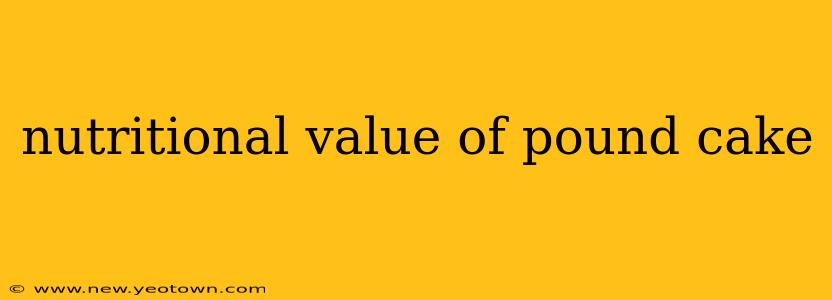The Sweet Truth: Unveiling the Nutritional Value of Pound Cake
Pound cake. The name itself evokes images of rich, buttery slices, perfect for a special occasion or a quiet afternoon treat. But beyond its delightful taste and texture, what's the real nutritional story behind this classic dessert? Let's delve into the nutritional value of pound cake, exploring its ingredients and their impact on our health.
It's important to preface this by saying that pound cake, by its very nature, is not a health food. It's a decadent treat to be enjoyed in moderation. However, understanding its nutritional profile allows us to make informed choices about our consumption.
What are the main ingredients in pound cake?
The traditional pound cake recipe gets its name from its equal proportions of butter, sugar, eggs, and flour. This simple yet effective combination is what gives pound cake its characteristic dense, moist texture. However, variations exist, with some recipes incorporating additional ingredients like milk, vanilla extract, or citrus zest. These additions can subtly alter the overall nutritional profile.
How many calories are in a slice of pound cake?
The calorie count of a slice of pound cake can vary significantly depending on the recipe and serving size. A standard slice (approximately 1/8 of a 9-inch cake) can contain anywhere from 300 to 400 calories. These calories predominantly come from the high fat and sugar content of the butter and sugar.
What are the macronutrients in pound cake?
Pound cake is primarily composed of carbohydrates, fats, and proteins. The carbohydrates mainly stem from the flour, while the fats come largely from the butter. The protein content is relatively low, mainly derived from the eggs. The exact macronutrient breakdown will vary based on the specific recipe and ingredients used.
Is pound cake high in sugar?
Yes, pound cake is generally high in added sugar. The large amount of sugar in the recipe contributes significantly to its sweetness and moist texture. Excessive sugar intake is linked to various health problems, including weight gain, tooth decay, and an increased risk of chronic diseases.
Does pound cake contain any vitamins or minerals?
While pound cake doesn't offer a significant amount of vitamins and minerals, it does contain some trace amounts from the eggs and flour. However, these are minimal compared to the high calorie and sugar content. It's not a primary source of essential nutrients.
How can I make pound cake healthier?
While completely transforming pound cake into a health food is challenging, you can make healthier choices:
- Reduce sugar: Use less sugar than called for in the recipe, or substitute with alternative sweeteners such as applesauce or mashed bananas (though this will change the texture and taste).
- Use whole wheat flour: Substituting some or all of the all-purpose flour with whole wheat flour adds fiber and nutrients.
- Add fruits and nuts: Incorporating fruits like berries or nuts adds fiber, vitamins, and antioxidants, offsetting some of the negative effects of the sugar and fat.
- Control portion size: Enjoying a smaller slice of pound cake helps limit your overall calorie and sugar intake.
In conclusion, pound cake is a delicious but calorie-dense treat best enjoyed in moderation. While it doesn't offer significant nutritional value compared to other foods, understanding its composition allows you to make informed choices and enjoy it responsibly. Remember to balance your indulgence with a healthy overall diet.

